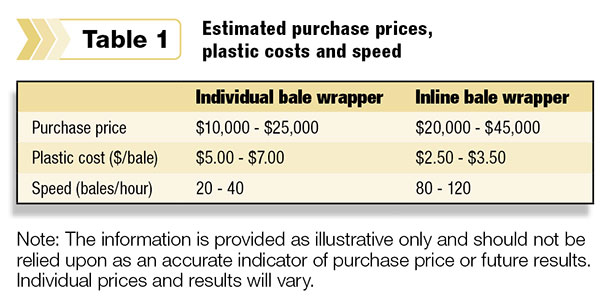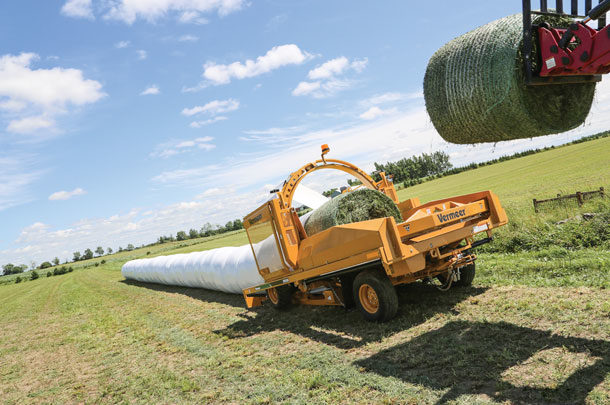Why are so many dairy farmers and beef producers now baling their high-moisture forages and grasses? There are several reasons:
- The extra cost required to bale high-moisture hay (versus dry hay) can easily be offset by reduced hay loss during harvesting, storage and handling. Dry bales stored outside, especially in high-humidity environments, can experience losses of 20 to 30 percent in just eight months.
- Forage is at the highest quality immediately after it’s cut. Therefore, wrapping high-moisture bales at that stage provides your cattle with the best-quality, high-protein feed value.
- And it’s more palatable. Refusal rates by cows eating dry hay can add another 10 to 20 percent in hay losses. Plus, with high-moisture baleage, there’s less shrink.
- Baling high-moisture forage allows you to harvest earlier and avoid damaging rain when dry hay crops are typically down. And it improves yields in later cuttings. For example, every extra day of delay (waiting to bale an alfalfa crop) amounts to a 6 percent yield loss on the following cutting. Therefore, waiting five days to bale hay can mean a 30 percent yield reduction.
- Wrapping high-moisture bales is an excellent option for both beef and dairy producers during wet and high-humidity hay seasons, especially if you consider today’s very unpredictable weather patterns.
- And if you’re starting from scratch, bale wrapping is roughly half the cost of investing in precision choppers, wagons and expensive storage facilities.
Baleage is a pretty inexpensive option for producers who rely heavily on baling hay and grazing. For the most part, you need a baler – one specifically designed for handling high-moisture forage.
Those designed with a robust pickup assembly, heavy-duty tines and a pre-cutting knife system will make a significant difference in terms of impact on performance, feeding and increased palatability.
The biggest cost after that is the plastic wrapper. Individual wrappers typically run anywhere from $12,000 to $25,000 at manufacturers’ suggested retail price.
From a return-on-investment standpoint, if you’re baling less than 500 bales per year, that’s probably the way to go. The higher-production inline wrappers are much faster, but they start at $20,000 and can cost up to $45,000 at manufacturers’ suggested retail price.
When to bale
We recommend wrapping hay at 45 to 55 percent moisture for best results. Different moisture levels result in different techniques and outcomes:
- 55 to 65 percent moisture – Great for fermentation, but you run the risk of leaving a wet, rank layer (1 to 2 inches deep) on the outside of the bale.
- 35 to 45 percent moisture – Minimal fermentation occurs, but it requires more layers of wrap. Bales can be fed up to a year later. At this range in moisture level, your primary goal is more about excluding oxygen than in creating good fermentation for stored bales.
- Less than 35 percent moisture – Less fermentation occurs. It requires an extra layer or two of plastic wrap. The bale needs to be fed quickly to reduce aerobic stability issues.
Individual vs. inline
What type of bale wrapping process best fits your operation? Before you decide, consider the following factors that may impact your decision:
- Initial cost of investment versus long-term cost efficiency
- Daily forage requirements for your dairy or beef operation
- The bale wrapping speed you’ll need to produce your total forage production capacity
- The versatility and convenience you need for sorting, select feeding, handling, storing and marketing plastic-wrapped bales
The two most popular bale wrapping processes used in the field today are inline wrapping and individual bale wrapping.
Inline wrapper
Using an inline wrapper cuts plastic usage in half. It also wraps faster than an individual wrapper. These are especially more practical for large-scale beef and dairy operations.
The disadvantages with an inline wrapper include the initial cost of the equipment (Table 1). Also, once you open an end-cap on a tube of bales, you need to keep feeding them at a minimum rate of one bale every one to two days to minimize spoilage.
 Inline-wrapped bales cannot be stacked, so storage requires more space, they’re less portable and, thus, less marketable after wrapping. It’s also important to uniformly size the bales to prevent air pockets.
Inline-wrapped bales cannot be stacked, so storage requires more space, they’re less portable and, thus, less marketable after wrapping. It’s also important to uniformly size the bales to prevent air pockets.
Individual wrapper
The initial capital investment of an individual wrapper is roughly half the cost of an inline wrapper. It’s a more practical alternative for producers who are feeding less than one bale per day or baling fewer than 500 bales per year. Individually wrapped bales are more marketable because they’re easier to transport and sell as individual packages.
An individually wrapped bale provides flexibility in sorting bales and feeding when compared to inline wrappers. There’s less potential for spoilage if one wrap is damaged or torn, as only one bale is affected rather than a tube of multiple bales. Individual bales can also be stacked to minimize space needed for in-field storage.
Disadvantages to the individual wrapper are that it uses twice as much plastic, is slower than an inline wrapper and is less efficient for large-scale livestock or dairy operators.
At the end of the day, the advantages and disadvantages fall pretty much in line with your needs for speed, capacity, flexibility and pocketbook. Large beef and dairy operators who place a premium on production over presentation will value the speed and efficiency of an inline wrapper. Those wanting more precision and flexibility at a lower price point will be inclined to go with an individual wrapper. PD
References omitted due to space but are available upon request. Click here to email an editor.
PHOTO: Photo provided by Josh Vrieze.
-
Josh Vrieze
- Product Manager
- Vermeer Corporation
- Email Josh Vrieze
Wrapping tips
- Wrap as soon as possible. We recommend wrapping no more than 24 hours after baling to begin the fermentation process. This will reduce the internal temperature of the bale and prevent aerobic deterioration.
- Net-wrap your bales. You get a smoother bale surface that contains the stems and reduces the chance of poking holes in the plastic film.
- Select blown, low-density polyethylene film around 1-mil thick.
- Pre-tension the film to stretch 55 to 75 percent. Excessive stretching allows oxygen and CO2 to pass through the film. Under-stretching won’t allow the bale to properly seal because the plastic won’t adhere properly. And don’t wrap during a rainstorm; wet film loses its tackiness.
- Use a minimum of six wraps using quality plastic. Different field and crop conditions impact the number of wraps per bale needed, so be sure to consult a local expert. Also, avoid rodenticide-treated sisal twine. It has the potential to degrade film.
- For best results, run your wrapped bales inline running north/south. Plastic film won’t degrade as quickly if you simply use the east-to-west path of the sun to uniformly balance bale exposure to ultraviolet rays.
- Wrap close to the storage site to minimize handling. Store away from trees, where birds and rodents are found. This reduces the chance of plastic film being damaged.
- Avoid sharp stubble areas and poorly drained soil.
- Periodically check for damage. If stems have poked through the film or you note rodent damage, repair immediately.
- After wrapping, don’t move or handle bales after 12 hours. Squeezing them can break film layers and potentially expose bales to oxygen, which can restart the aerobic phase.
Baleage tips provided by Josh Vrieze (Vermeer Product Manager) and Kevin Shinners (Professor of Agricultural Engineering, University of Wisconsin – Madison).






